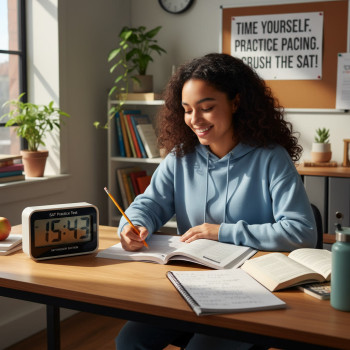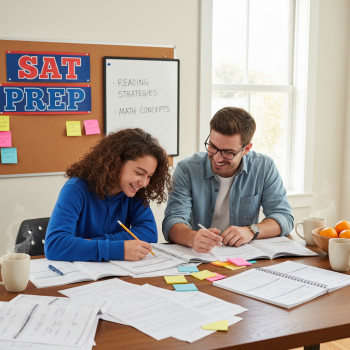Why a Newspaper Habit Is One of the Best Unofficial SAT Shortcuts
Ask any high-scoring student what gave them an edge on the Digital SAT and you’ll hear the usual suspects: practice tests, a steady study plan, and time management. But there’s a quieter, older habit that keeps popping up in those conversations — reading newspapers. It sounds almost too simple, but daily engagement with well-edited journalism builds a set of reading and thinking muscles that are exceptionally useful for the SAT. This post teases apart why that is, how to read with purpose for the test, and how to fold newspapers into a modern, smart study routine (including where Sparkl’s personalized tutoring can help if you want tailored guidance).
The link between newspaper reading and SAT success — what’s actually happening?
Newspapers train several cognitive skills that the Digital SAT rewards. The Reading and Writing section asks you to quickly understand passages, analyze author choices, and select precise, evidence-based answers. Newspapers do this implicitly by presenting:
- Dense, information-rich paragraphs that require active reading.
- Arguments, opinions, and reported facts — perfect practice for passage-based reasoning.
- Varied vocabulary and sentence structures, which sharpen word sense and context clues.
When students read quality journalism for months, they start recognizing patterns: how authors build claims, where evidence lives, rhetorical techniques writers use to persuade, and how meaning changes with small shifts in wording. That pattern recognition reduces the time and effort required to understand a Digital SAT passage and increases accuracy when selecting answers.
Reading newspapers improves the exact SAT skills that count
Let’s map the real progress newspaper readers make to specific SAT skills:
- Contextual vocabulary: The ability to determine a word’s meaning from context reduces guessing and helps with evidence-based questions.
- Author’s purpose and tone: Editorials and features are practice labs for identifying point of view — a frequent SAT task.
- Evidence-based reasoning: News articles show claims followed by facts or data; recognizing that structure helps you find and cite textual evidence during the test.
- Synthesizing information: Long-form reporting often requires readers to combine multiple details into a coherent understanding — just like multi-part passages on the SAT.
- Critical evaluation: Distinguishing reporting from opinion and spotting weak argumentation helps on questions that ask you to evaluate reasoning or identify assumptions.
How to read newspapers the SAT way (not just skim headlines)
Not every minute you spend with a paper is equally valuable. Here’s a practical, step-by-step way to read newspapers intentionally for SAT gains.
1. Choose the right sections
Pick sections with substance: national news, science, opinion, and long-form features. Avoid pure lifestyle clickbait and short celebrity items — they’re fun, but they rarely mimic the passages you’ll see on test day.
2. Read actively
Active reading means asking a few quick questions as you go: What’s the main point? What evidence supports it? Is the author making assumptions? When a paragraph contains a statistic or quote, mentally mark it as probable evidence you could cite later.
3. Summarize in one sentence
After each article or major section, try to summarize the main idea in a single sentence. This trains condensation—turning long passages into crisp takeaways, which is what you’ll do when scanning SAT passages for the correct answer.
4. Track unfamiliar words the smart way
Don’t collect every new word like trophies. When a new word appears, do this: (1) Read the sentence and identify clues; (2) Write a simple definition in your own words; (3) Make a short example sentence. This strengthens contextual vocabulary rather than rote memorization.
5. Use newspapers for timed practice
Once a week, simulate a Digital SAT reading block with a long feature article. Time yourself: read and answer 8–10 quick comprehension prompts you create from the piece (main idea, inference, tone, evidence location). This builds both speed and analytical precision.
Concrete study routines: blend newspapers into your SAT plan
Below are routines for different time budgets. Pick one to fit your schedule and combine it with official practice tests and focused review.
Daily 20-minute routine (best for busy students)
- 5 minutes: Scan headlines and choose one article.
- 10 minutes: Read actively, marking the thesis and two pieces of evidence.
- 5 minutes: Summarize and note one new word with an example sentence.
Weekly 60–90 minute routine (deep practice)
- 15 minutes: Choose a long-form feature or major investigative piece.
- 30–40 minutes: Read slowly and annotate — track claims, evidence, and rhetorical devices.
- 15 minutes: Write a one-paragraph synthesis and create 8 practice questions (main idea, vocabulary, evidence location, function of a paragraph).
- Optional: Discuss your findings with a tutor or study partner.
Monthly diagnostic crossover
Once a month, compare a newspaper article to an official Digital SAT passage. Ask: Is the level of detail similar? How does the author structure the argument? Use this to calibrate your reading difficulty and adjust your newspaper choices.
How newspaper reading builds non-academic advantages that matter on test day
Beyond direct reading skills, newspapers offer soft advantages that show up in test performance.
- Improved focus: Long articles demand sustained attention — the same stamina you need for a multi-section exam.
- Reduced anxiety: Familiarity with dense texts lowers the surprise factor when you open a tough passage.
- Curiosity and background knowledge: Articles about science, history, or culture quietly build the contextual scaffolding that makes inference questions easier.
- Better time allocation: Practice distinguishing core ideas from details so you spend minutes where they matter most on test day.
Practical tools: making your newspaper habit efficient
Newspapers are everywhere — print, websites, apps. Here are ways to make the habit study-friendly without stealing all your free time.
- Use article playlists: save 3–5 long reads each week in a notes app and rotate.
- Annotate digitally: highlight, comment, and extract key sentences into a study document.
- Keep a one-page reading log: article title, source, date, key idea, and one test-like question you created.
- Discuss articles: brief explanations to friends or tutors solidify comprehension and reveal gaps.
Sample table: What to read versus what SAT passages resemble
| Newspaper Section | Typical Article Type | Why It Helps SAT Reading | Practice Activity |
|---|---|---|---|
| National/International News | Objective reporting, summaries of events | Builds factual-comprehension and evidence location | Find the sentence that best supports the lead claim |
| Opinion/Editorial | Arguments, persuasion, rhetorical devices | Sharpens author-purpose and tone analysis | Identify the author’s main assumption and one counterargument |
| Science & Tech | Explanatory pieces, data summaries | Improves understanding of complex information and jargon | Summarize the mechanism in two sentences |
| Features/Long-Form | Narratives, profiles, investigations | Mirrors long SAT passages; trains synthesis and inference | Create 8 practice questions and time yourself |
Examples: turning real articles into SAT practice
Here are quick templates you can use any time you read an article. These mirror common Digital SAT question types and make your reading high-yield.
- Main idea: Summarize the author’s argument in one sentence.
- Evidence location: Which paragraph contains the statistic or quote that best supports the main idea?
- Vocabulary in context: Replace a challenging word with a synonym that keeps the author’s tone intact.
- Function question: Why did the author include a specific anecdote — to illustrate, to contrast, or to provide evidence?
- Inference: Based on the article, what is the author likely to believe about a related topic?
How to combine newspaper habits with official Digital SAT practice
Newspapers are a powerful supplement, but they don’t replace targeted test prep. Blend habits like this:
- Alternate daily newspaper reading with short, focused SAT practice sets (e.g., 20 minutes of question practice targeting one skill).
- Use newspaper articles to warm up before a practice test — 10–15 minutes of active reading heightens focus.
- After a practice test, revisit related newspaper pieces to reinforce weak areas (for example, read more science features if passage-based science questions were tough).
When to get extra help — and how Sparkl fits in
Some students develop newspaper habits organically and soar; others need structure and feedback to convert reading time into measurable score gains. That’s where personalized tutoring is invaluable. A few ways tailored coaching (like Sparkl’s 1-on-1 guidance) can accelerate results:
- Custom reading plans that match your current score and target score — so your articles are challenging but not discouraging.
- Expert tutors who model think-alouds while reading, showing you exactly how to annotate and extract evidence.
- AI-driven insights that identify which article types most improve your weak question types and recommend focused practice.
- Practice schedules that integrate newspaper reading with official practice tests, pacing you so gains are steady and measurable.
If you’re the kind of student who benefits from feedback on thinking processes and tailored accountability, combining newspapers with a tutor’s guidance can turn a passive habit into targeted score improvement.
Common mistakes students make when using newspapers for SAT prep
Newspaper reading can be powerful but only if done thoughtfully. Avoid these traps:
- Passively skimming headlines — this builds little transferable skill.
- Collecting vocabulary lists without context — leads to shallow retention.
- Reading only one type of article — variety builds adaptable reasoning.
- Not timing reading practice — speed is nearly as important as comprehension on test day.
Quick FAQs
How much newspaper reading is enough?
Consistency matters more than volume. Twenty minutes a day of active reading for three months will produce noticeable gains for most students. Combine that with weekly timed practice and targeted review.
Should I read print or online?
Either works. Print can help you focus; online gives access to archives and search. Whichever you choose, be deliberate about annotation and question-creation.
Are certain newspapers better for SAT prep?
Choose reputable outlets with clear editing and longer features. The point isn’t brand prestige — it’s exposure to tightly argued, well-structured prose.
Final thoughts: reading newspapers is slow, steady advantage
Preparing for the Digital SAT is often framed as a mechanical endeavor — drill these question types, learn these rules, beat the clock. But reading newspapers trains a different, complementary muscle: the capacity to absorb complicated ideas, evaluate evidence, and read carefully yet efficiently. That combination is priceless on test day.
If you’re ready to make the habit intentional, start small: pick a reliable article today, read it actively for 15–20 minutes, and write a one-sentence summary. If you want a faster path from habit to score, consider adding personalized support — a tutor can show you how to turn your reading into measurable improvement with targeted practice plans and feedback. Sparkl’s 1-on-1 guidance, tailored study plans, and AI-driven insights are designed to do exactly that — fit the reading habit to your strengths and convert it into SAT success.
One last tip
Think of newspapers as a long-term investment. Scores don’t climb overnight, but regular, purposeful reading compounds. In a few months you’ll notice not just higher accuracy on reading passages, but a greater ease with complex texts — a skill that helps beyond the SAT, through college and into life.
















No Comments
Leave a comment Cancel